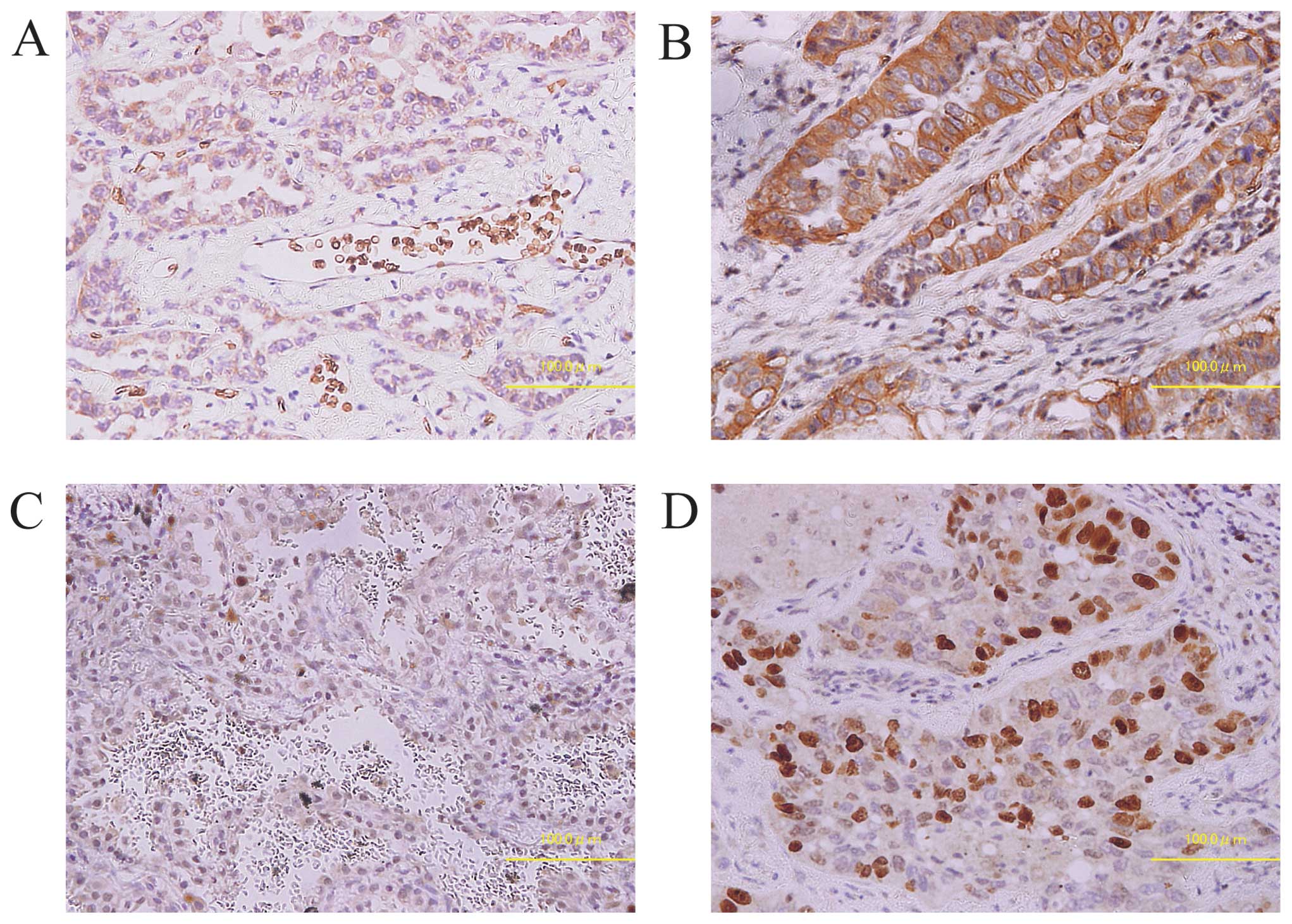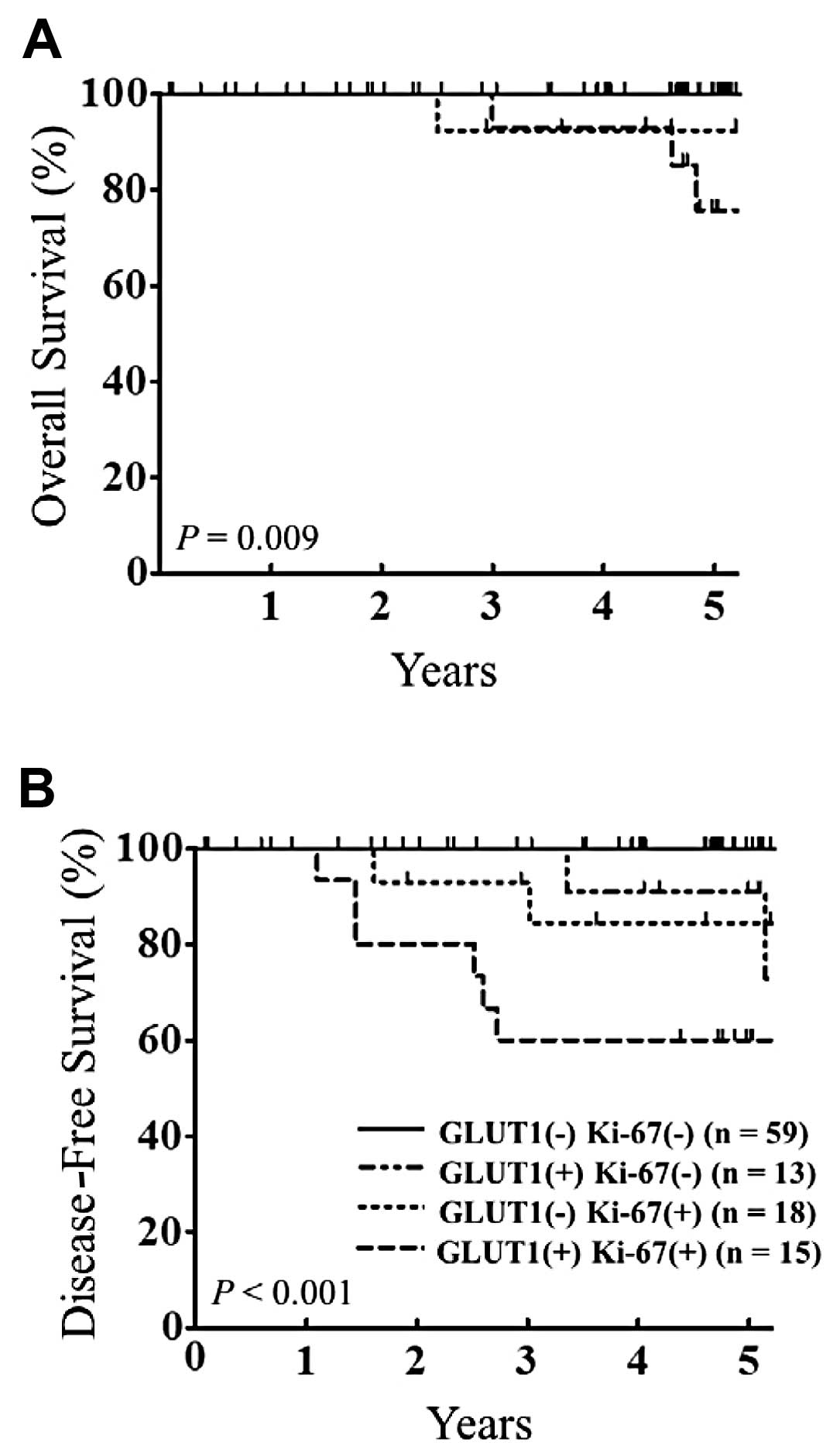|
1
|
Ferlay J, Shin HR, Bray F, Forman D,
Mathers C and Parkin DM: Estimates of worldwide burden of cancer in
2008: GLOBOCAN 2008. Int J Cancer. 127:2893–2917. 2010. View Article : Google Scholar : PubMed/NCBI
|
|
2
|
Jemal A, Bray F, Center MM, Ferlay J, Ward
E and Forman D: Global cancer statistics. CA Cancer J Clin.
61:69–90. 2011. View Article : Google Scholar
|
|
3
|
Devesa SS, Bray F, Vizcaino AP and Parkin
DM: International lung cancer trends by histologic type:
male:female differences diminishing and adenocarcinoma rates
rising. Int J Cancer. 117:294–299. 2005. View Article : Google Scholar : PubMed/NCBI
|
|
4
|
van Rens MT, de la Riviere AB, Elbers HR
and van Den Bosch JM: Prognostic assessment of 2,361 patients who
underwent pulmonary resection for non-small cell lung cancer, stage
I, II, and IIIA. Chest. 117:374–379. 2000.PubMed/NCBI
|
|
5
|
Koike T, Kimura N, Miyazaki K, et al:
Hypoxia induces adhesion molecules on cancer cells: A missing link
between Warburg effect and induction of selectin-ligand
carbohydrates. Proc Natl Acad Sci USA. 101:8132–8137. 2004.
View Article : Google Scholar : PubMed/NCBI
|
|
6
|
Wood IS and Trayhurn P: Glucose
transporters (GLUT and SGLT): expanded families of sugar transport
proteins. Br J Nutr. 89:3–9. 2003. View Article : Google Scholar : PubMed/NCBI
|
|
7
|
Kalir T, Wang BY, Goldfischer M, et al:
Immunohistochemical staining of GLUT1 in benign, borderline, and
malignant ovarian epithelia. Cancer. 94:1078–1082. 2002. View Article : Google Scholar : PubMed/NCBI
|
|
8
|
Carvalho KC, Cunha IW, Rocha RM, et al:
GLUT1 expression in malignant tumors and its use as an
immunodiagnostic marker. Clinics (São Paulo). 66:965–972.
2011.PubMed/NCBI
|
|
9
|
Koukourakis MI, Giatromanolaki A,
Bougioukas G and Sivridis E: Lung cancer: a comparative study of
metabolism related protein expression in cancer cells and tumor
associated stroma. Cancer Biol Ther. 6:1476–1479. 2007.PubMed/NCBI
|
|
10
|
Wang K, Sun Y and Wang T: The prognostic
significance of GLUT1 expression in stage I and II NSCLC. Zhongguo
Fei Ai Za Zhi. 5:451–453. 2002.(In Chinese).
|
|
11
|
Brown DC and Gatter KC: Ki67 protein: the
immaculate deception? Histopathology. 40:2–11. 2002. View Article : Google Scholar
|
|
12
|
Jalava P, Kuopio T, Juntti-Patinen L,
Kotkansalo T, Kronqvist P and Collan Y: Ki67 immunohistochemistry:
a valuable marker in prognostication but with a risk of
misclassification: proliferation subgroups formed based on Ki67
immunoreactivity and standardized mitotic index. Histopathology.
48:674–682. 2006. View Article : Google Scholar
|
|
13
|
Scholzen T and Gerdes J: The Ki-67
protein: from the known and the unknown. J Cell Physiol.
182:311–322. 2000. View Article : Google Scholar : PubMed/NCBI
|
|
14
|
Goldhirsch A, Ingle JN, Gelber RD, Coates
AS, Thurlimann B and Senn HJ: Thresholds for therapies: highlights
of the St Gallen International Expert Consensus on the primary
therapy of early breast cancer 2009. Ann Oncol. 20:1319–1329. 2009.
View Article : Google Scholar : PubMed/NCBI
|
|
15
|
Klintman M, Bendahl PO, Grabau D, Lovgren
K, Malmstrom P and Ferno M: The prognostic value of Ki67 is
dependent on estrogen receptor status and histological grade in
premenopausal patients with node-negative breast cancer. Mod
Pathol. 23:251–259. 2010. View Article : Google Scholar : PubMed/NCBI
|
|
16
|
Minami K, Saito Y, Imamura H and Okamura
A: Prognostic significance of p53, Ki-67, VEGF and Glut-1 in
resected stage I adenocarcinoma of the lung. Lung Cancer. 38:51–57.
2002. View Article : Google Scholar : PubMed/NCBI
|
|
17
|
Tungekar MF, Gatter KC, Dunnill MS and
Mason DY: Ki-67 immunostaining and survival in operable lung
cancer. Histopathology. 19:545–550. 1991. View Article : Google Scholar : PubMed/NCBI
|
|
18
|
Simony J, Pujol JL, Radal M, Ursule E,
Michel FB and Pujol H: In situ evaluation of growth fraction
determined by monoclonal antibody Ki-67 and ploidy in surgically
resected non-small cell lung cancers. Cancer Res. 50:4382–4387.
1990.PubMed/NCBI
|
|
19
|
Mehdi SA, Etzell JE, Newman NB, Weidner N,
Kohman LJ and Graziano SL: Prognostic significance of Ki-67
immunostaining and symptoms in resected stage I and II non-small
cell lung cancer. Lung Cancer. 20:99–108. 1998. View Article : Google Scholar : PubMed/NCBI
|
|
20
|
Cappuzzo F, Hirsch FR, Rossi E, et al:
Epidermal growth factor receptor gene and protein and gefitinib
sensitivity in non-small-cell lung cancer. J Natl Cancer Inst.
97:643–655. 2005. View Article : Google Scholar : PubMed/NCBI
|
|
21
|
Ichihara S, Toyooka S, Fujiwara Y, et al:
The impact of epidermal growth factor receptor gene status on
gefitinib-treated Japanese patients with non-small-cell lung
cancer. Int J Cancer. 120:1239–1247. 2007. View Article : Google Scholar : PubMed/NCBI
|
|
22
|
Toyooka S, Mitsudomi T, Soh J, et al:
Molecular oncology of lung cancer. Gen Thorac Cardiovasc Surg.
59:527–537. 2011. View Article : Google Scholar : PubMed/NCBI
|
|
23
|
Travis WD, Brambilla E, Noguchi M, et al:
International association for the study of lung cancer/american
thoracic society/european respiratory society international
multidisciplinary classification of lung adenocarcinoma. J Thorac
Oncol. 6:244–285. 2011. View Article : Google Scholar
|
|
24
|
Travis WD, Brambilla E, Muller-Hermelink
HK and Harris CC: World Health Organization Classification of
Tumours. Pathology and genetics of tumours of the lung, pleura,
thymus and heart. IARC Press; Lyon: 2004
|
|
25
|
Rami-Porta R, Crowley JJ and Goldstraw P:
The revised TNM staging system for lung cancer. Ann Thorac
Cardiovasc Surg. 15:4–9. 2009.PubMed/NCBI
|
|
26
|
Jun YJ, Jang SM, Han HL, Lee KH, Jang KS
and Paik SS: Clinicopathologic significance of GLUT1 expression and
its correlation with Apaf-1 in colorectal adenocarcinomas. World J
Gastroenterol. 17:1866–1873. 2011. View Article : Google Scholar : PubMed/NCBI
|
|
27
|
Parente P, Coli A, Massi G, Mangoni A,
Fabrizi MM and Bigotti G: Immunohistochemical expression of the
glucose transporters Glut-1 and Glut-3 in human malignant melanomas
and benign melanocytic lesions. J Exp Clin Cancer Res. 27:342008.
View Article : Google Scholar
|
|
28
|
Yerushalmi R, Woods R, Ravdin PM, Hayes MM
and Gelmon KA: Ki67 in breast cancer: prognostic and predictive
potential. Lancet Oncol. 11:174–183. 2010. View Article : Google Scholar : PubMed/NCBI
|
|
29
|
Dowsett M, Nielsen TO, A’Hern R, et al:
Assessment of Ki67 in Breast Cancer: recommendations from the
international Ki67 in Breast Cancer working group. J Natl Cancer
Inst. 103:1656–1664. 2011. View Article : Google Scholar : PubMed/NCBI
|
|
30
|
Goldhirsch A, Wood WC, Coates AS, Gelber
RD, Thurlimann B and Senn HJ: Strategies for subtypes - dealing
with the diversity of breast cancer: highlights of the St. Gallen
International Expert Consensus on the Primary Therapy of Early
Breast Cancer 2011. Ann Oncol. 22:1736–1747. 2011. View Article : Google Scholar : PubMed/NCBI
|
|
31
|
Colozza M, Sidoni A and Piccart-Gebhart M:
Value of Ki67 in breast cancer: the debate is still open. Lancet
Oncol. 11:414–415. 2010. View Article : Google Scholar : PubMed/NCBI
|
|
32
|
Jonat W and Arnold N: Is the Ki-67
labelling index ready for clinical use? Ann Oncol. 22:500–502.
2011. View Article : Google Scholar : PubMed/NCBI
|
|
33
|
Asano H, Toyooka S, Tokumo M, et al:
Detection of EGFR gene mutation in lung cancer by mutant-enriched
polymerase chain reaction assay. Clin Cancer Res. 12:43–48. 2006.
View Article : Google Scholar : PubMed/NCBI
|
|
34
|
Tokumo M, Toyooka S, Kiura K, et al: The
relationship between epidermal growth factor receptor mutations and
clinicopathologic features in non-small cell lung cancers. Clin
Cancer Res. 11:1167–1173. 2005.PubMed/NCBI
|
|
35
|
Suehisa H, Toyooka S, Hotta K, et al:
Epidermal growth factor receptor mutation status and adjuvant
chemotherapy with uracil-tegafur for adenocarcinoma of the lung. J
Clin Oncol. 25:3952–3957. 2007. View Article : Google Scholar : PubMed/NCBI
|
|
36
|
Watanabe S, Watanabe T, Arai K, Kasai T,
Haratake J and Urayama H: Results of wedge resection for focal
bronchiolo-alveolar carcinoma showing pure ground-glass attenuation
on computed tomography. Ann Thorac Surg. 73:1071–1075. 2002.
View Article : Google Scholar
|
|
37
|
Yamada S and Kohno T: Video-assisted
thoracic surgery for pure ground-glass opacities 2 cm or less in
diameter. Ann Thorac Surg. 77:1911–1915. 2004. View Article : Google Scholar : PubMed/NCBI
|
|
38
|
Sasaki H, Shitara M, Yokota K, et al:
Overexpression of GLUT1 correlates with Kras mutations in lung
carcinomas. Mol Med Rep. 5:599–602. 2012.PubMed/NCBI
|
|
39
|
Yun J, Rago C, Cheong I, et al: Glucose
deprivation contributes to the development of KRAS pathway
mutations in tumor cells. Science. 325:1555–1559. 2009. View Article : Google Scholar : PubMed/NCBI
|
|
40
|
Furudoi A, Tanaka S, Haruma K, et al:
Clinical significance of human erythrocyte glucose transporter 1
expression at the deepest invasive site of advanced colorectal
carcinoma. Oncology. 60:162–169. 2001. View Article : Google Scholar
|
|
41
|
Noguchi M, Morikawa A, Kawasaki M, et al:
Small adenocarcinoma of the lung. Histologic characteristics and
prognosis. Cancer. 75:2844–2852. 1995. View Article : Google Scholar : PubMed/NCBI
|
|
42
|
Yokose T, Suzuki K, Nagai K, Nishiwaki Y,
Sasaki S and Ochiai A: Favorable and unfavorable morphological
prognostic factors in peripheral adenocarcinoma of the lung 3 cm or
less in diameter. Lung Cancer. 29:179–188. 2000. View Article : Google Scholar : PubMed/NCBI
|
|
43
|
Yoshida J, Nagai K, Yokose T, et al:
Limited resection trial for pulmonary ground-glass opacity nodules:
fifty-case experience. J Thorac Cardiovasc Surg. 129:991–996. 2005.
View Article : Google Scholar : PubMed/NCBI
|
















